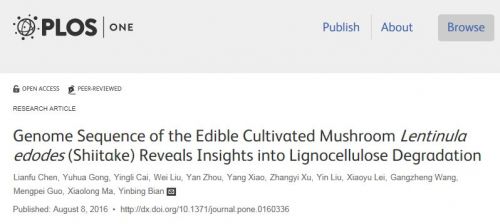
Recently, Prof. Bian Yinbing research team in our university online published an article titled Ge-nome sequence of the edible cultivated mushroom Lentinula edodes (shiitake) reveals insights into Lignocellulose degradation on PLoS ONE. It marks that China’s independent release of genome reference sequence and annotation of L.edodes which preliminarily reveals insights into the genetic material basis of L. edodes lignocellulose degradation. The article offers a better understanding of improving the transforming and using efficiency of L. edodes cultivation medium and developing new cultivation medium. Ph.D. candidate Chen Lianfu is the first author, and Prof. Bian Yinbing is the corresponding author. The study was supported by the National Natural Science Foundation of China.
L. edodes is a kind of edible fungus with longest cultivation history and largest yield and exports in China. It’s known as the National Mushroom as it is widely cultivated across the country. L. edodes possesses unique aroma components, rich nutrition and medicinal value, which render shiitake overwhelmingly popular with consumers in Asian countries. However, L. edodes cultivation is mostly dependent on forests resources as its main cultivation material is sawdust, so it is very nec-essary to develop cultivation medium like straw.
The team completed genome assembly, annotation and analysis by selecting Shiitake monokaryot-ic strain W1-26 for genome sequencing. The team reported 41.8Mb genome, encoding 14,889 pre-dicted genes or so. Genes annotation and its function predication shows that sL. edodes genome consists of 102 protease genes involving in the degradation of ligncellulose, and defines the species composition and quantities of enzyme genes in the degradation of ligncellulose. Due to the discov-ery of significant increase of the expression level of two cellulase genes and sixteen transcription-factor genes in cellulase cultivation medium by combing with transcriptome data, both molecule mechanism research on L. edodes degraded cellulose and the structure analysis on L. edodes mat A and matB loci are being further conducted. Furthermore, seven γ-ggt genes and five csl genes relat-ing to metabolic shiitake-aroma components, far more than other fungus species, have been verified. In addition, phylogeny analysis indicates that L. edodes has the closest genetic relationship with gymnopus luxurians.
The publication of L. edodes genome provides better bioinformatic platform for functional genome research of L. edodes. It also offers a better understanding of cultivating new type L. edodes with high yield and good quality, and improving utilization efficiency of cultivation medium and devel-oping new medium. Meanwhile, it contributes to further scientific study of edible fungus.
(By Li Yumei)
http://news.hzau.edu.cn/2016/0901/46447.shtml
